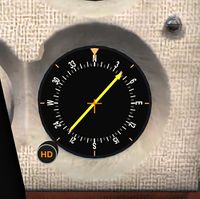Bendix King KR 87 ADF Receiver
The Bendix King KR 87 ADF receiver, equipped in the C172p and other planes. It features tuning into NDBs in the KHz range for driving a MDI needle and two timers.
Operation
When powered and tuned to a station, the ADF receiver can send the stations signal to your speakers. For that, at the audio panel the corresponding switch must be active. You should use this to verify the morse code of the tuned station to match the ID you expect from your map, so you know you really are listening to the station you intended, and furthermore, also to be sure, you really receive a signal at all!
Power / Volume
Power to the unit it switched with the volume-knob.
- OFF: In the leftmost position, the unit is powered-off.
- ON: If rotated to the right, the unit is switched on. You can control the units volume (for ident code) with the knob.
ADF / MDI display

When the ADF-button is depressed (ADF is annunciated), the signals direction is evaluated automatically and sent to the MDI display unit. The signal thus drives the needle, which will point to the senders direction. Usually, the needle has a 90° resting position, so be sure you verify the signal by checking the morse code.
A common operating error is to not have ADF mode active, leaving you wondering why the needle won't indicate.
BFO
The BFO (Beat Frequency Oscillator) mode can optionally be activated by pressing the BFO button.
In short: Press BFO when you tune into a station and cannot hear the morse code.
More details: Outside of the United States some stations are unmodulated and use an interrupted carrier for identification purposes. The BFO mode, activated and annunciated when the “BFO” button is depressed, permits the carrier wave and the associated Morse code identifier broadcast on the carrier wave to be heard.
See https://aviation.stackexchange.com/questions/47011/how-and-when-to-use-the-bfo-button-on-an-adf for more technical details.
Frequency mode (FRQ)
The unit boots into the FRQ mode at startup. On the left, you see the currently active frequency the unit is listening to. The right side shows the standby frequency.
When pushing the FRQ-button, both frequencies will be swapped, so the standby frequency is now the active one.
Timer modes (FT/ET)
The unit has a flight timer (FT) and a Enroute timer (ET). You can cycle them using the FT/ET button. The currently active mode is indicated by a steady FT or ET annunciator.
To go back to the FRQ mode, just press the FRQ button once.
When in FT/ET mode, the frequency selection knobs will directly adjust the selected frequency, not adjusting the stored standby frequency. This may be useful to scan for stations.
Flight timer (FT)
The flight timer activates automatically when the unit is powered on. It counts upwards and cannot be reset.
It shows flight time since power on in the format MM:SS. After one hour, it shows HH:MM.
Enroute timer (ET) / countdown mode
The enroute timer also activates automatically with power, but pressing the SET/RST button will reset it to 00:00.
It shows elapsed time since last reset in the format MM:SS. After one hour, it shows HH:MM.
It also features a countdown mode:[1]
- When you press SET/RST for more than two seconds, you enter SET mode.
- In SET mode, the ET-annunciator will flash. Now you can turn the inner and outer knob to adjust the desired countdown time up to 59 minutes and 59 seconds.
- When you are satisfied, press SET/RST again to activate the countdown.
- Once the time is over, the unit will show the ET timer flashing. The timer then continues to count upwards. Additionally an aural alert can be heard for about 1 second.
See also
- Bendix KR 87 manual: https://www.bendixking.com/content/dam/bendixking/en/documents/downloads/006-18110-0000_5-Pilot-s-Guide.pdf (p. 41ff)
- ↑ as of FGFS 2020.4 in the C172P and C182S

